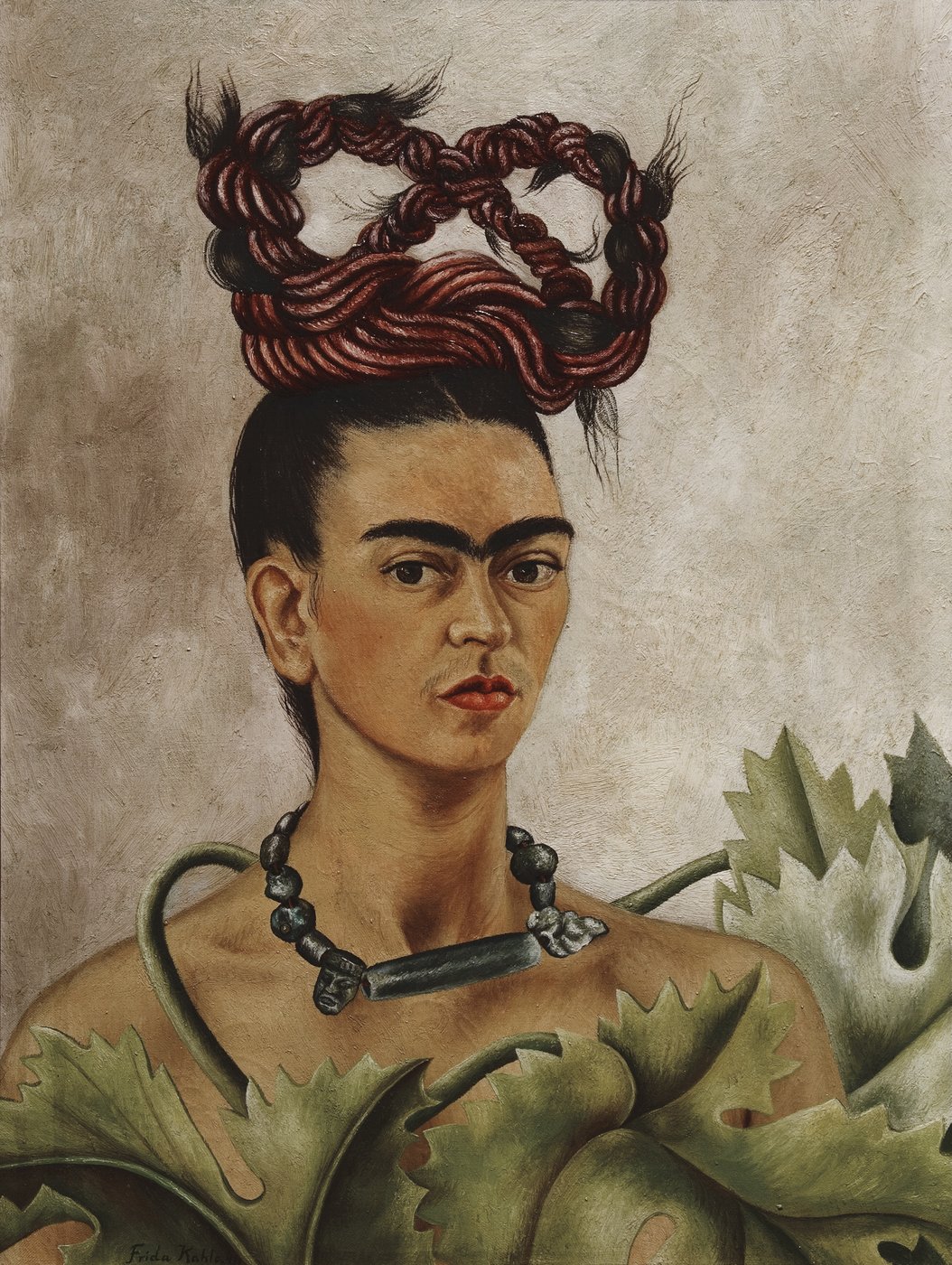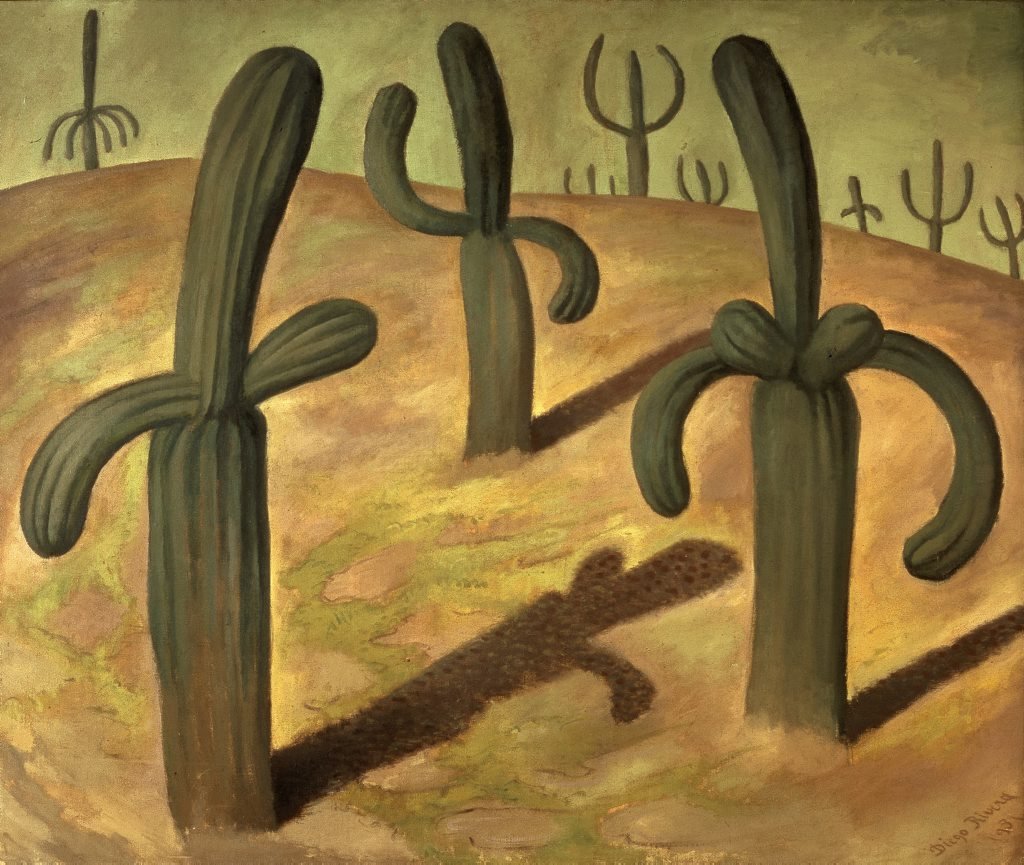Menu
Frida Kahlo and Diego Rivera
from the Jacques and Natasha Gelman Collection 25 Jun – 23 Oct 2016
At home

Frida Kahlo, 'Self-portrait with braid', 1941
La Casa Azul was the house where Frida Kahlo was born, where she lived with her husband Diego Rivera, and where she died.
Casa Azul and the garden she designed for it would become Frida’s domestic haven and the heart of her artistic milieu.
In the Mexico City suburb of Coyoacán, the house was filled not just with international artists, but with film stars from Hollywood and Mexico, intellectuals and political activists.
Enlarge
Guillermo Zamora, 'Frida and Diego, Coyoacán', 1937
Frida and Diego moved in to Casa Azul after Frida’s parents died, but before then, they had already made an important contribution to Mexican architecture.
In 1931, Frida and Diego engaged the pioneering modernist architect Juan O’Gorman to design them a house and studio in San Ángel.
The avant-garde O’Gorman built them what was to become a significant – at the time, controversial – building, combining Mexican vernacular motifs with the rationalist or functionalist approach championed by Le Corbusier.
The light and airy double house was a ‘his and hers’ of two minimal blocks. The large white and dark pink block was Diego’s studio, and the bright blue smaller house, linked by a bridge, was Frida’s space.
Enlarge
Acme Photo, 'Diego and Frida in NYC', 1933
Late in 1933 when they returned to Mexico from the US, Frida and Diego took up residence at the O’Gorman house in San Ángel.
Though Diego would keep using the studio, in 1941 after Frida’s father died, the Riveras moved out of their twin houses and in to Casa Azul.
After all the difficulties of their own relationship, with its year-long separation, divorce and remarriage, it was at Casa Azul that they found some stability – and made a home.
Enlarge
Florence Arquin, 'Untitled (Frida Kahlo in Coyoacán, Mexico)', c1940
Frida’s first act at Casa Azul was to paint the traditional whitewashed house the same bright cobalt blue she’d enjoyed in San Ángel. It was a colour Mexican folklore held would ward off evil spirits.
She redesigned her mother’s more typical middle-class garden, creating an open courtyard for living in night and day and adding ponds and fountains.
Enlarge
Diego Rivera, 'Landscape with cacti', 1931
Frida introduced indigenous plants such as agaves, aloes, yuccas and cactus. She also planted jasmines and jacarandas, to create a lush and inviting space that she filled with pre-Hispanic sculptures, ceramics and objects.
Casa Azul became an extension of Frida’s artistic practice and of her own personal style.
Enlarge
Frida Kahlo, 'Self-portrait with monkeys', 1943
Frida and Diego kept a menagerie of unusual pets at Casa Azul.
There was the tame eagle, Gertrude Caca Blanca, named for the white droppings it left throughout the courtyard.
Then there were the monkeys: the spider monkey Fulang Chang that Diego gave her (who became famous after appearing in one of Frida’s self-portraits) and one called Caimito de Guayabal, after a kind of guava.
Enlarge
Fritz Henle, 'Frida in front of studio with monkey, Coyoacán', 1943
For the Aztecs, the monkey was a symbol of fertility, dance and the arts – as well as a symbol of lust.
Then there was the large male Amazon parrot, Bonito, or ‘beautiful one’, who used to get drunk on tequila and swear like a trooper.
Enlarge
Lola Alvarez Bravo, 'Frida Kahlo', 1944
But it was Frida’s native Mexican Xoloitzcuintli dogs that were her favourite pets.
The Aztecs saw these small hairless dogs as guides to the afterlife. Their name comes from the Aztec god Xólotl and the Nahuatl word for dog, itzcuintli.
Enlarge
Hector Garcia, 'Frida Kahlo with Itzcuintli Dog', 1952
Her favourite dog, Señor (‘Mr’) Xólotl, became legendary, making an appearance in several paintings including one of her most famous, The Love Embrace of the Universe, the Earth (Mexico), Diego, Me, and Señor Xólotl 1949.
Diego was so angry with Señor Xólotl once when he peed on several freshly painted watercolours, that he nearly killed him – but the cute little dog’s wagging tail and imploring eyes saved him just in time.
Enlarge
Bernard Silberstein, 'Frida with objects on shelves', c1940
Over the years Frida filled the lively and ever-changing space with folk art and popular curios including the skulls and huge papier-mâché effigies of Judas from the Day of the Dead celebrations – even a small pink pyramid covered in Aztec idols.
Frida also grew native plants for the table – corn, prickly pears and pitahayas (dragon fruits). Some of these would turn up in her late still-lifes.
Reflecting on their life at Casa Azul, Frida once said: ‘How we painted the house and the Mexican furniture, all that influenced my painting a lot … I began to make paintings with backgrounds and Mexican things in them.’
Enlarge
Diego Rivera, 'Emmy Lou Packard and Frida Kahlo in Coyoacán', 1941
At Casa Azul, Frida and Diego hosted the who’s who of Mexico’s intellectual and cultural elite. They also greeted guests from around the world who, in the 1920s and 30s, flocked to Mexico as an exciting, progressive place to be.
They entertained a remarkable group of friends including: film stars like ‘Cantinflas’; film directors like the Russian Arcady Boytler; Costa Rican singer Chavela Vargas; Guatemalan writer Luis Cardoza y Aragón; the Chilean Pablo Neruda and French surrealist André Breton.
Art patrons such as Eduardo Morillo Safa and the Gelmans came, as well as an endless stream of artists from British sculptor Henry Moore to close friends Alice Rahon and Emmy Lou Packard.
Enlarge
Florence Arquin, 'Untitled (Frida Kahlo in wheel chair with sun umbrella)', c1950
Perhaps the most famous guest at Casa Azul was one of the leaders of the Russian revolution – by then exiled by Stalin – Leon Trotsky.
Trotsky and his wife Natalia Sedova were granted asylum in Mexico and came to stay at Casa Azul for two years.
Some of their guests, like film stars Paulette Goddard, Delores Del Rio and Maria Felix, were Diego’s lovers. Others – of both sexes, and including Trotsky – were Frida’s.
Rumour has it that one of her lovers, the sculptor and designer Isamu Noguchi, climbed an orange tree to escape Diego Rivera’s gun-wielding wrath.
That same tree still grows at Casa Azul today.
Enlarge
